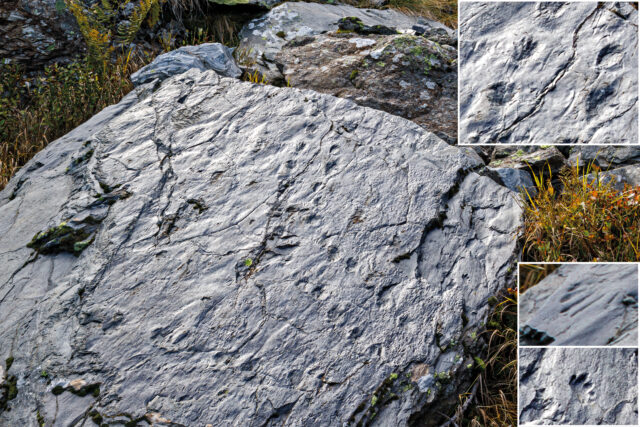A single fossil offering a glimpse into the far and ancient past is an incredible discovery to any who make it, but what about an entire ecosystem? The information that could be provided by such a find would be momentous. Well, that’s exactly what happened when a woman hiking in the Italian Alps stumbled upon a 280 million-year-old world, complete with animal tracks, plant fossils and even imprints of raindrops!
Discovering an ancient world in the Italian Alps

Claudia Steffensen and her husband were hiking in Valtellina Orobie Mountain Park, in Lombardy, Italy, when she made the jaw-dropping discovery. “It was a very hot day last summer, and we wanted to escape the heat, so we went to the mountains. On our way back down, we had to walk very carefully along the path,” she told The Guardian.
On their way down, Steffensen had stepped on a curious-looking rock. At first glance, it looked like a slab of cement, but upon closer inspection, she realized there was more to it. “I then noticed these strange circular designs with wavy lines,” she said. “I took a closer look and realized they were footprints.”
She brought this to the attention of experts, who took the time to analyze the rock and determined the strange lines were actually footprints belonging to a prehistoric reptile. Astounded by the discovery, which has since been dubbed “Rock Zero,” researchers ventured to the site where Steffensen discovered the rock, and what they found was absolutely remarkable.
New discoveries were made at ‘Rock Zero’

After visiting the site multiple times, researchers discovered evidence of an entire ecosystem. frozen in time. They dated it back to the Permian Period, which occurred 299-252 million years ago. It was characterized by a fast-warming climate, which resulted in a mass extinction, wiping out around 90 percent of the Earth’s water species and 70 percent of those residing on land. This event has become known as the “Great Dying.”
Within this ancient ecosystem, experts found several fossilized footprints from all kinds of creatures: reptiles, insects, anthropods and amphibians. Among them, they also identified traces of ancient leaves, stems and seeds. What was perhaps most remarkable was the discovery of raindrop imprints in the stone, as well as wave lines from a prehistoric lake that once lapped at the long-gone shoreline.
These discoveries weren’t found in just one place, either. Evidence of this ancient ecosystem was noted 9,850 feet high up the mountain range, down to the bottom of the valley. This is likely due to landslides that would have deposited the fossil-bearing rocks far from their original position.
How have they been preserved all this time?

The question remains: how were these traces able to withstand the test of time? Their preservation is thanks to their proximity to water.
As explained by Ausonio Ronchi, a palaeontologist at the University of Pavia, “The footprints were made when these sandstones and shales were still sand and mud soaked in water at margins of rivers and lakes, which periodically, according to the seasons, dried up. The summer sun, drying out those surfaces, hardened them to the point that the return of new water did not erase the footprints but, on the contrary, covered them with new clay, forming a protective layer.”
Thus far, the tracks have been identified as belonging to at least five different species, some of which may have been comparable in size to modern-day Komodo dragons.
Cristiano Dal Sasso, a vertebrae palaeontologist at the Natural History Museum of Milan, explained, “At that time, dinosaurs did not yet exist, but the animals responsible for the largest footprints found here must still have been of a considerable size.”
Dal Sasson continued, explaining how these fossils would’ve likely remained hidden if it hadn’t been for climate change, and that studying them can teach us about what the world is experiencing today.
More from us: ‘Medieval’ Site Linked to King Arthur is 4,000 Years Older Than Initially Thought
Want to become a trivia master? Sign up for our Today In History newsletter!
“These fossils […] testify to a distant geological period, but with a global warming trend completely similar to that of today. The past has a lot to teach us about what we risk getting the world into now.”
